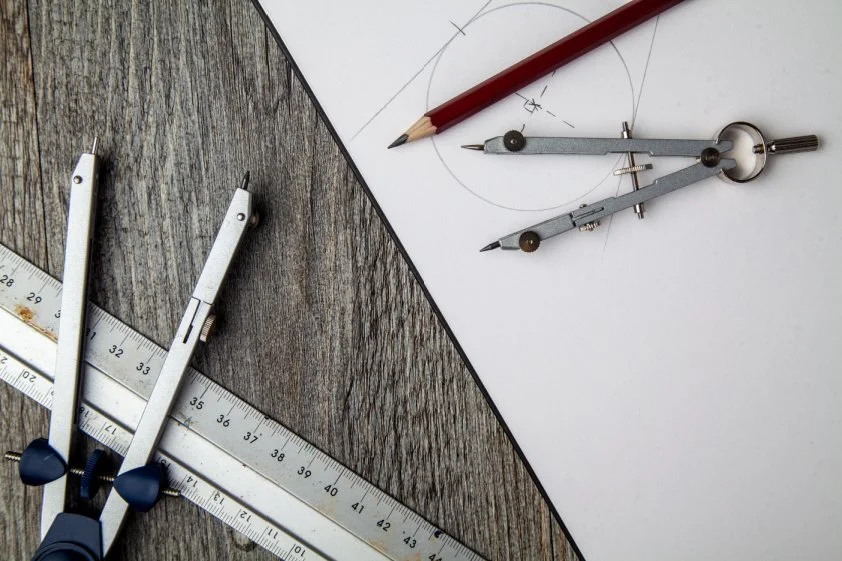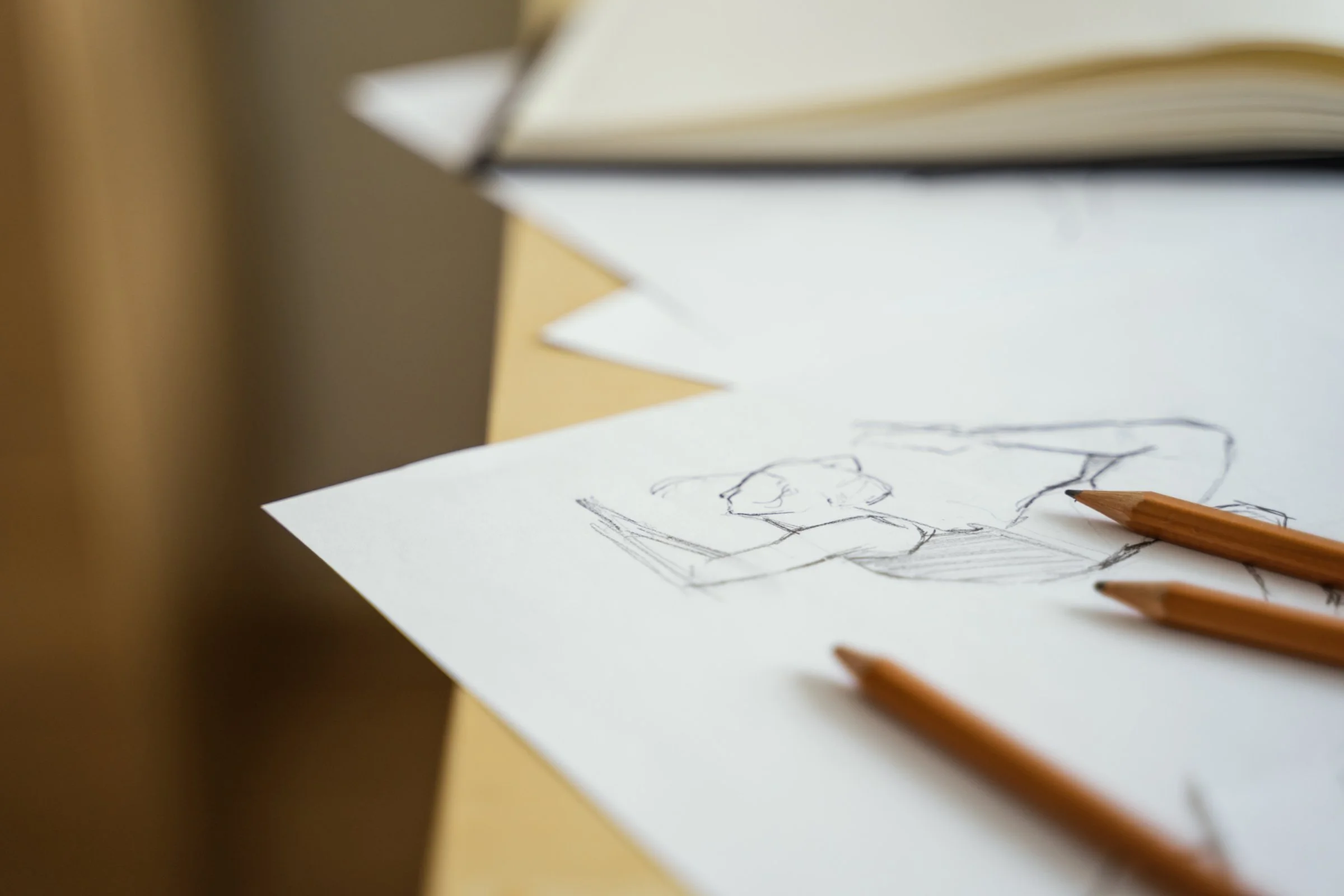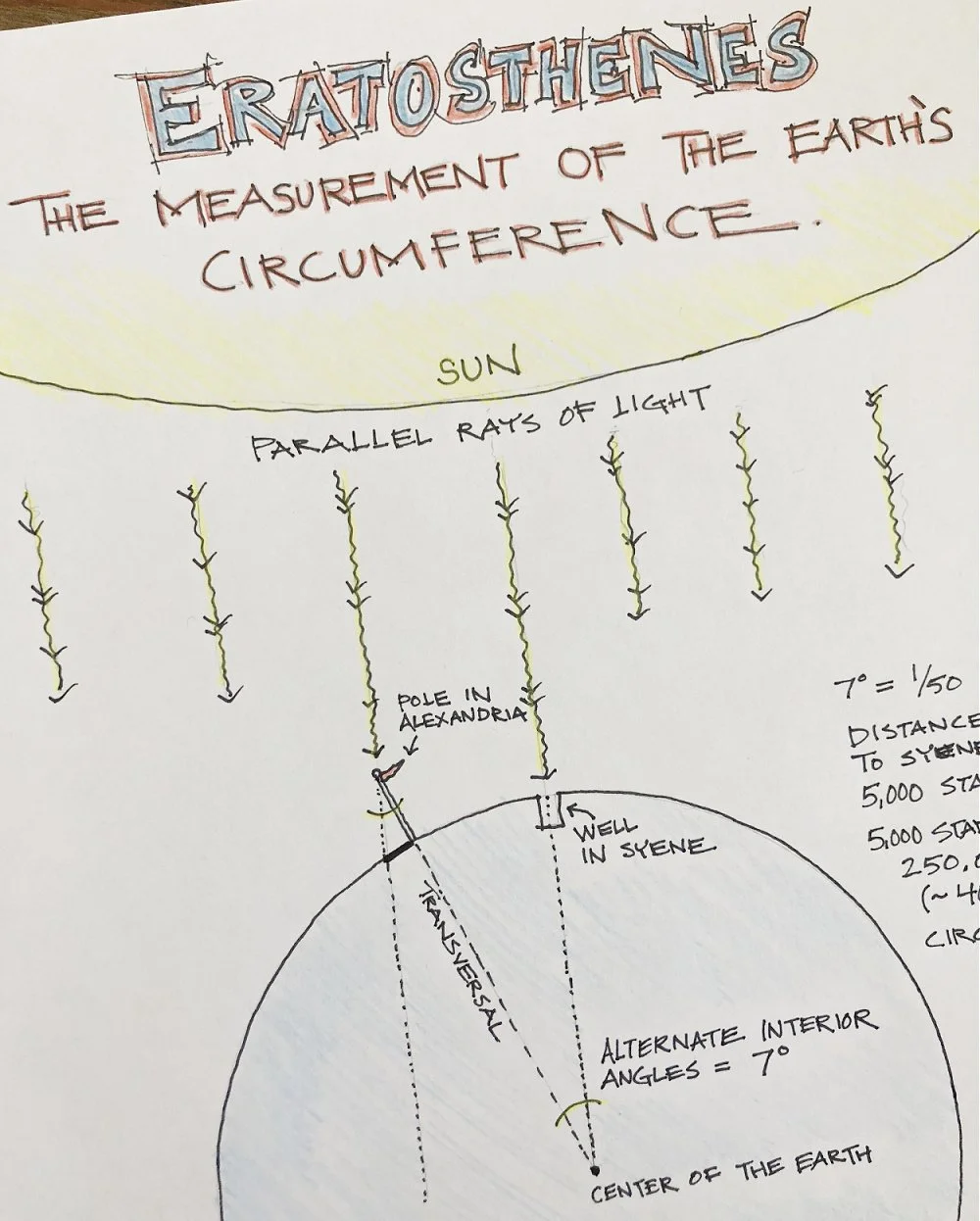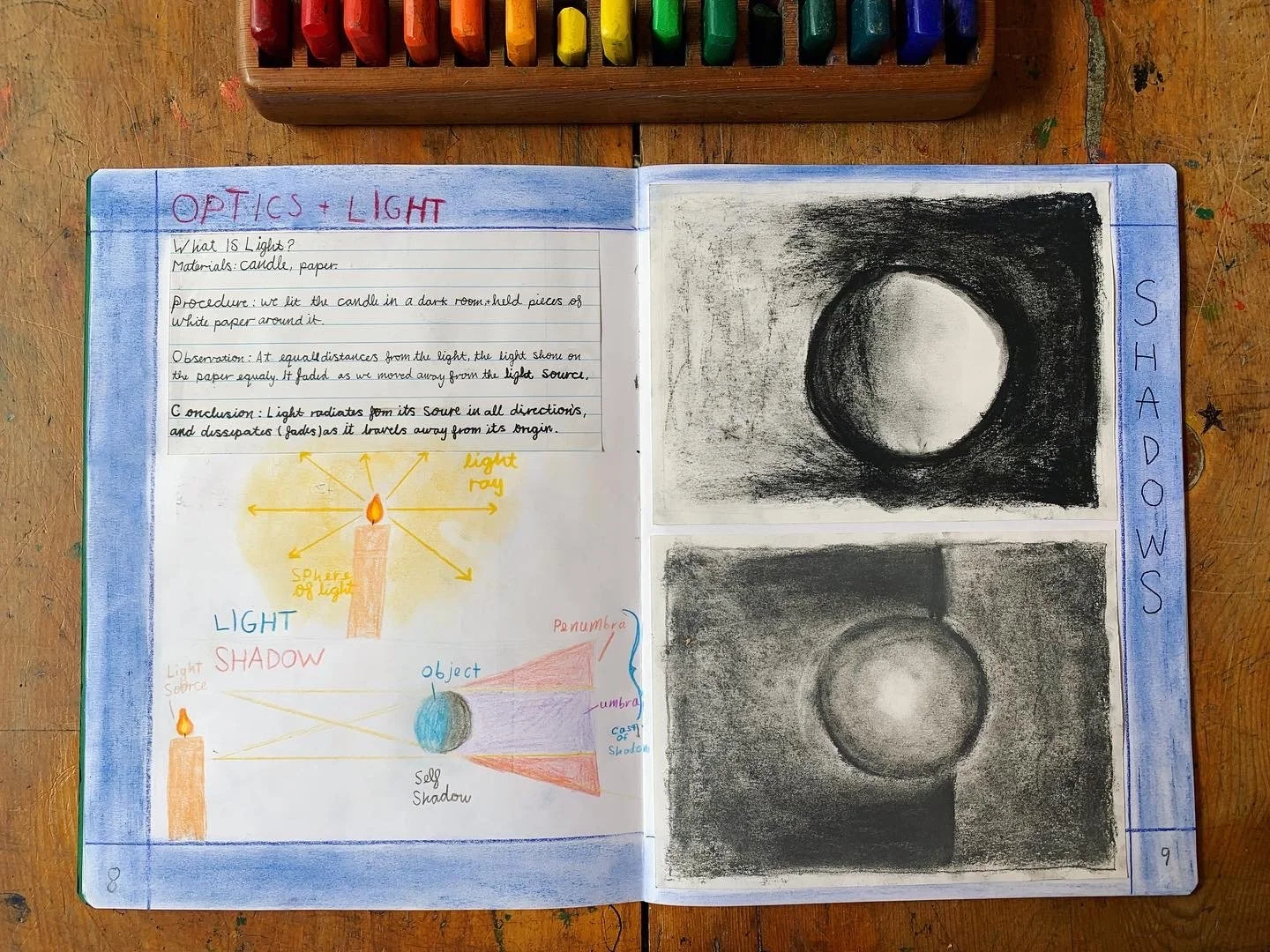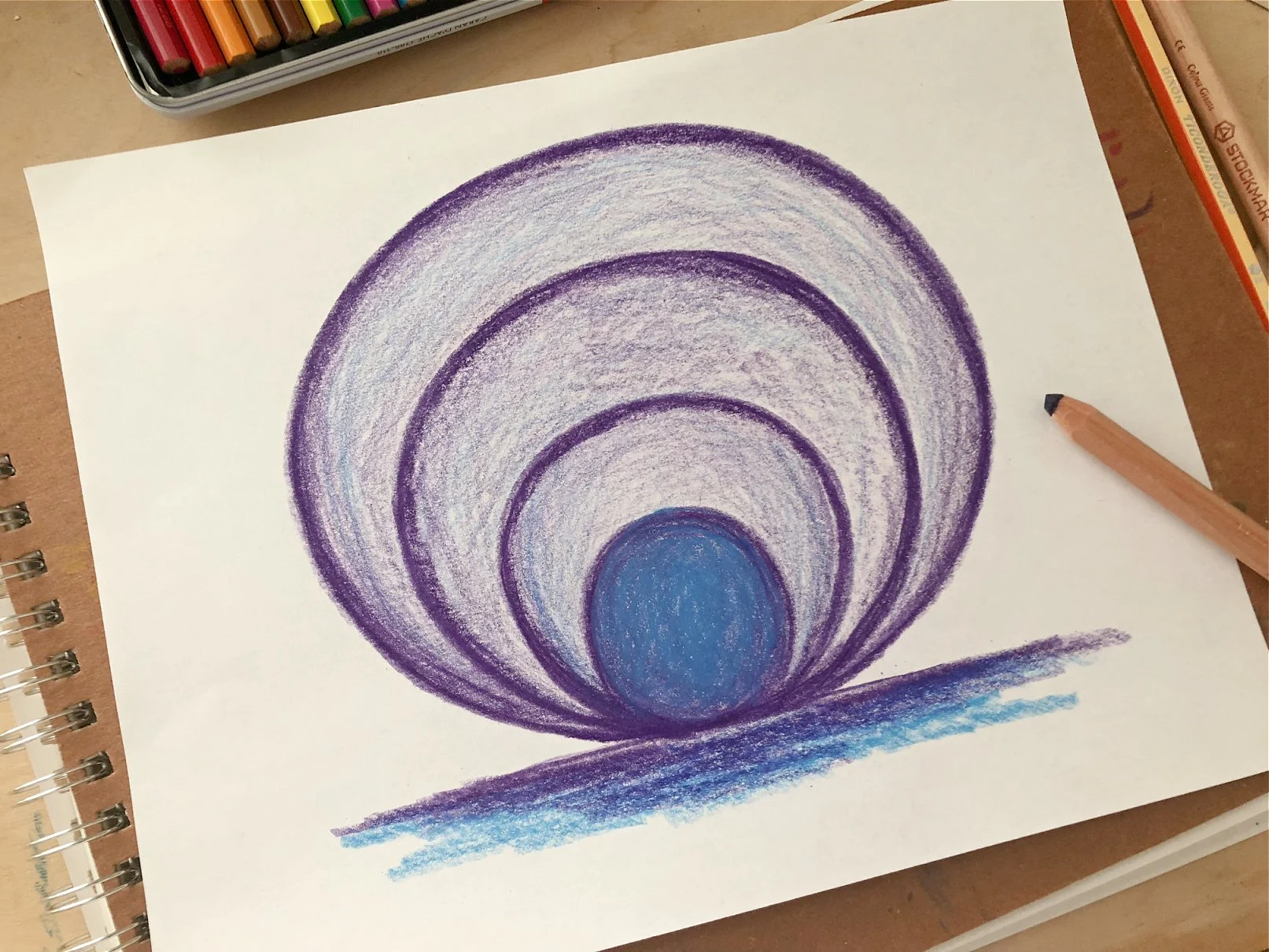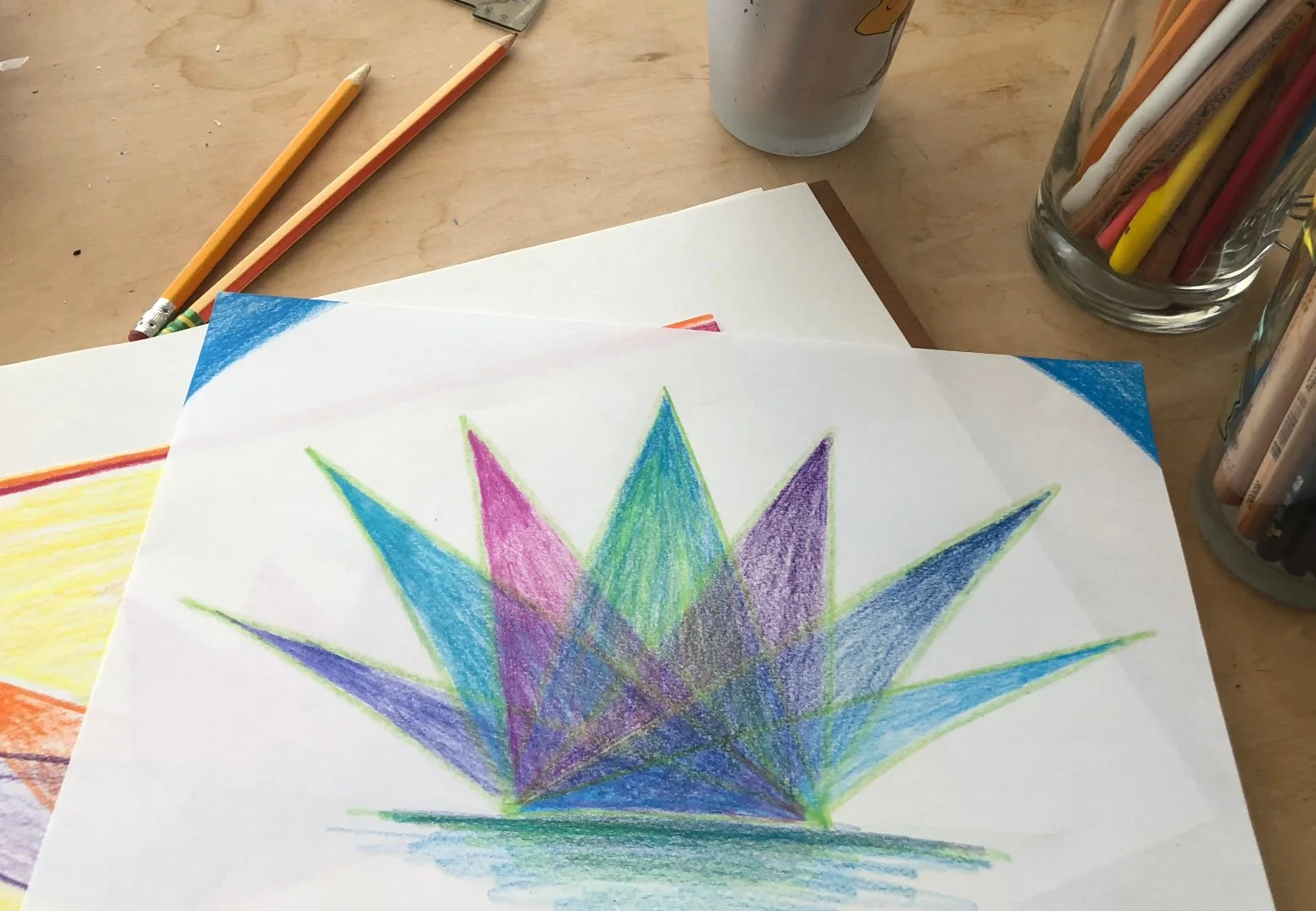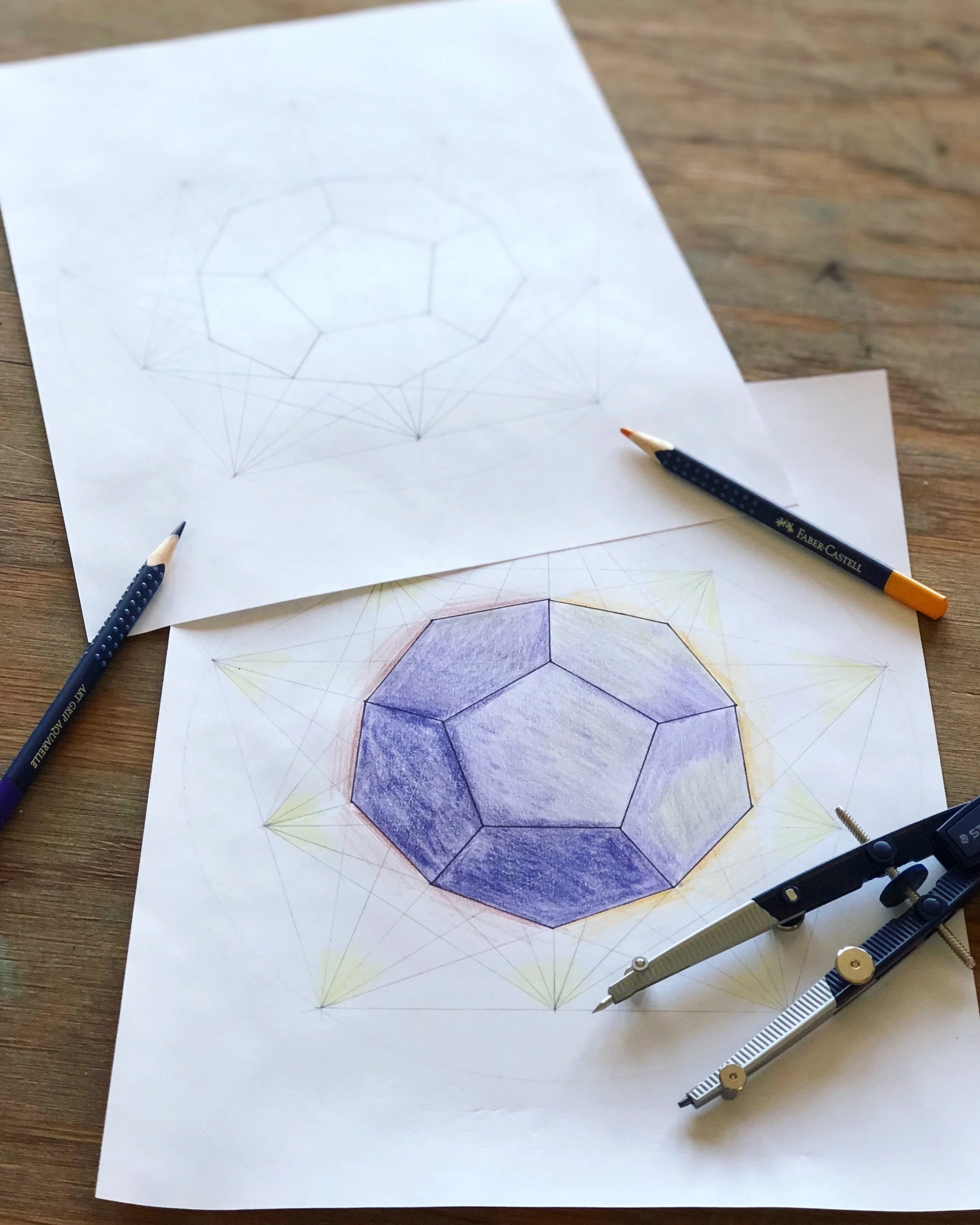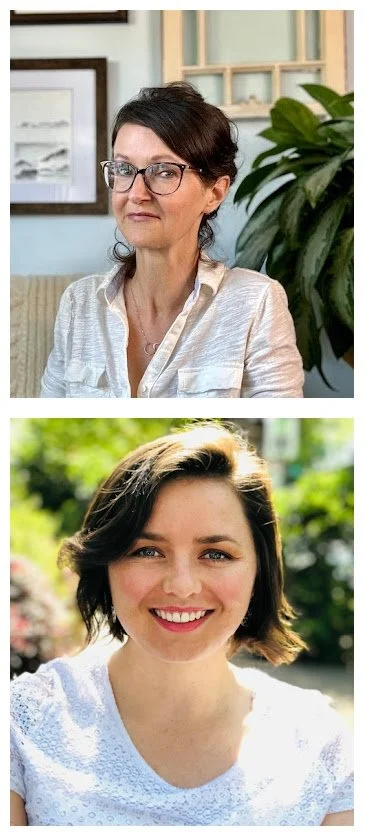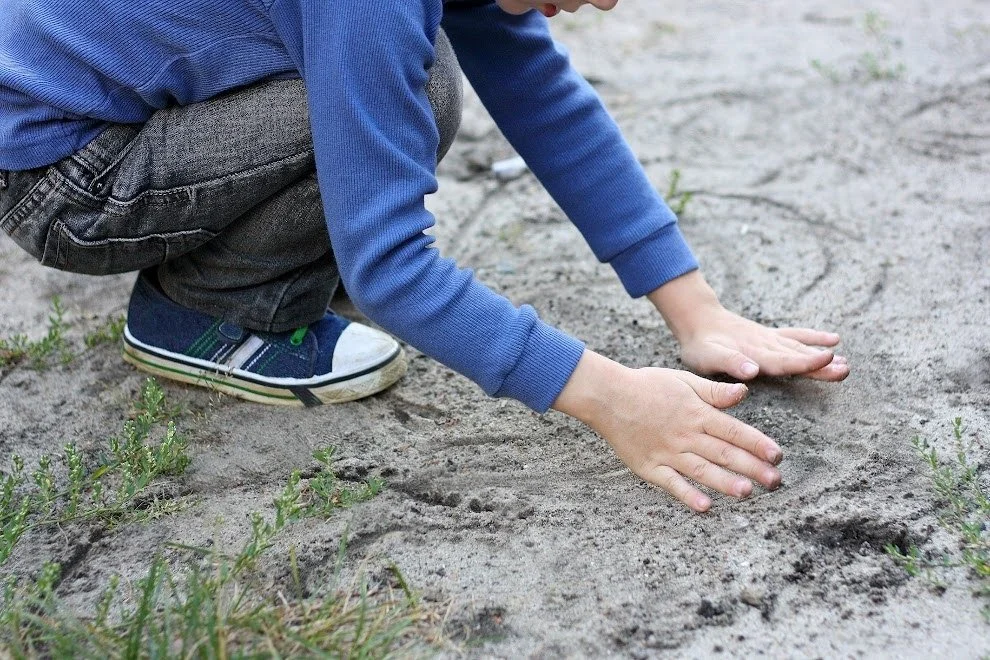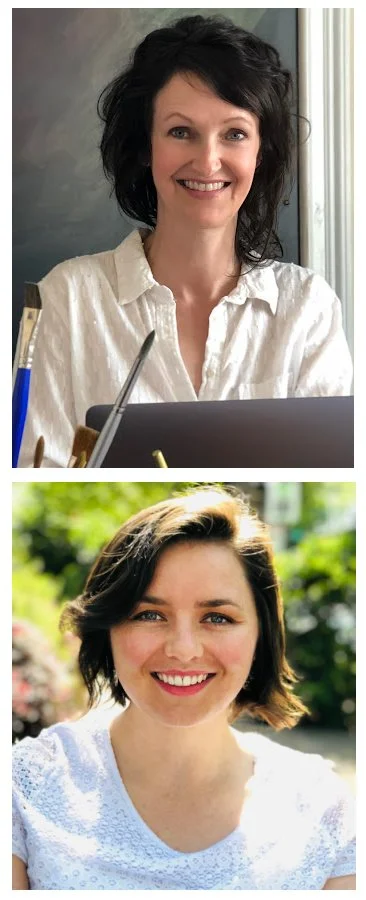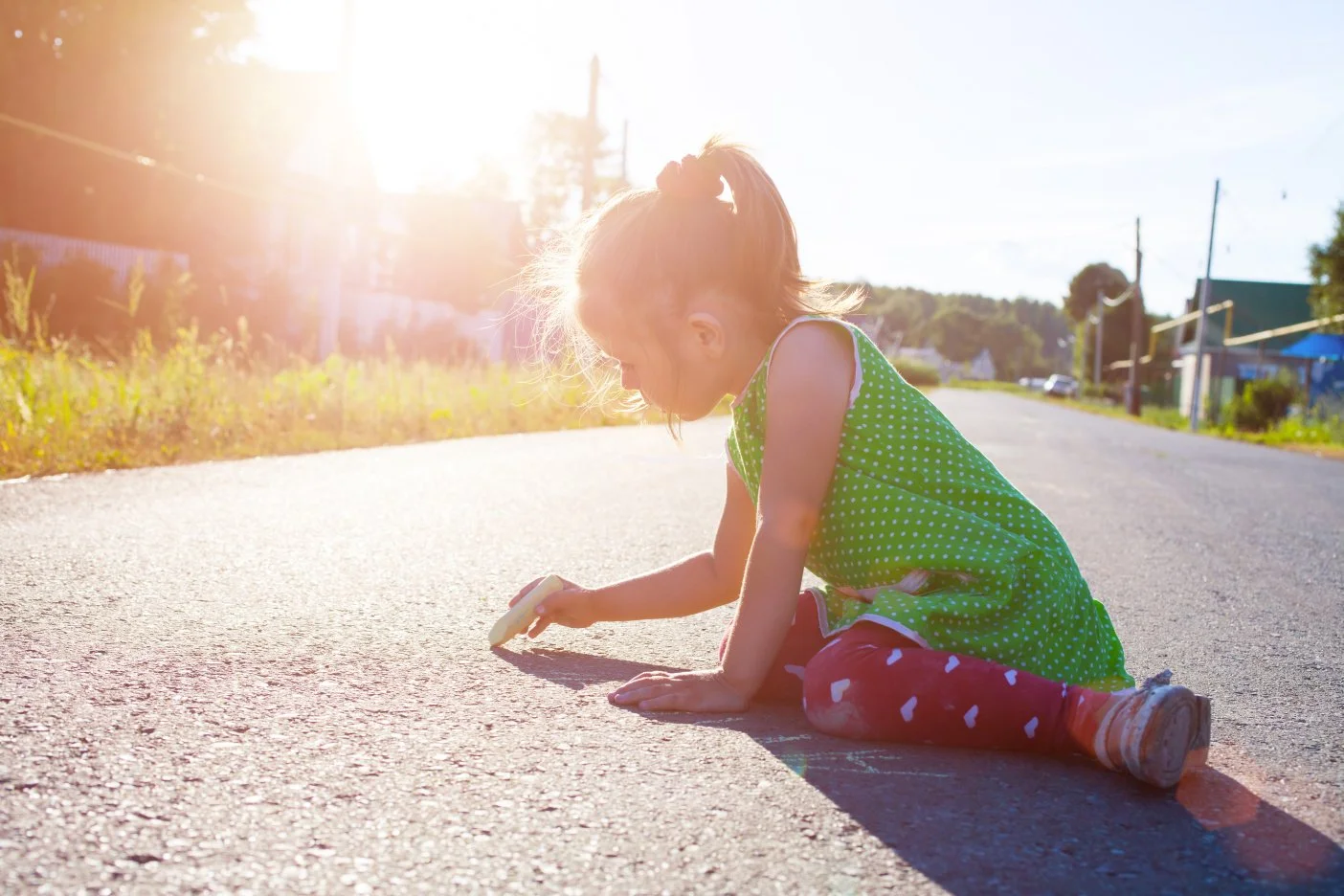
Waldorfish Blog
Waldorf Form Drawing: My child wants to turn all their form drawings into pictures - is this ok?
Waldorf form drawing is a subject that requires regular practice. This can mean drawing on a chalkboard, on the sidewalk, in sand, or on paper!
Form drawing can be an inspirations for all kinds of creative illustrations!
The activity of drawing forms generates a portfolio of practice and more finished forms, from running forms in first grade, all the way up to woven forms in fourth grade.
As the educator presents these forms through imagination and stories, children tend to see forms as great potential for drawings and unique artwork. The running form could be a slithering snake; mirror forms are a butterfly in progress; the vertical line form is an unfinished fence for sheep. The possibilities for drawings made from form drawings are endless!
Should children take their forms and turn them into drawings? Is it part of the form drawing experience? These are great questions to consider!
The short answer: yes, it is perfectly fine for a child to turn their form drawings into unique and artistic pictures, however, this activity is separate from what form drawing brings to a child’s development and educational experience.
Form drawing and drawing pictures from forms are two separate processes, and it is important for the educator to keep them independent of each other.
Be sure to keep the form drawing practice as a stand-alone activity.
Take the time to fully introduce the form through story or image. Practice forms in a rhythmical, regular way, and remember that practice is by far the most important process of the form drawing. Hold the thread of the intentional practice to the end, so that the child can fully experience the form and all that it is meant to bring to their developmental growth.
When that process is fully complete, and the particular form has been put to rest, it is then a wonderful activity to take the forms and use them as the foundations to imaginative artwork.
Practice, enjoy, and create!
About the Authors
Robyn Beaufoy is Waldorfish’s CEO, and also a course instructor for Simple Season (coming soon!), Waldorf Art for Beginners, and Weekly Art Foundations. You’ll find her intuitive touches and influences throughout everything Waldorfish offers! Robyn has been in the world of education for over 25 years, with an MA in Education and a certification in Waldorf teaching - she also homeschooled both of her children for some of that time. In 2012 Robyn co-founded Waldorfish.com, creating it with the vision of making Waldorf inspired-art and pedagogy more accessible, joyful, and doable for homeschoolers all over the world.
Caitlin Amajor is Waldorfish’s course instructor for Geometry grades 5 & 6, and Botany, as well as our Administrative Assistant. From a young age, Caitlin has been immersed in Waldorf education, attending a Waldorf school from K-8. After receiving a BA in History, Caitlin gained her certification in Waldorf teaching, and spent seven years as a Waldorf class teacher in the upper grades. With a special fondness for watercolor painting and geometry, Caitlin loves bringing Waldorf education to her students all over the world, and seeing their own individuality and style bloom from the curriculum!
Waldorf 5th Grade Geometry Curriculum: Building a Strong Foundation
A freehand geometric form of growing circles.
In Waldorf curriculum, fifth grade marks the beginning of geometry studies.
Thus far, students have built their understanding of forms through Form Drawing lessons and their abilities in spatial awareness, pencil grip, balance and symmetry have grown through those experiences.
In fifth grade, it's time to jump into Geometry, and begin exploring its foundations!
The fifth grade child is in a particularly special time in childhood, often referred to as the “golden age.” Physically, they are balanced and graceful; stronger and more sure in their movements than that of a young child, and without the awkwardness that often marks the physicality of a teenager.
Inwardly, they are uniquely in-between the magic of early childhood and the realism of middle school. They are discovering a newfound curiosity and desire to understand how the world works in the present and what has happened in the past – all while finding beauty and magic in every aspect.
Finding beauty in truth- the fifth grader is ready to explore geometry!
Fifth grade geometry curriculum is rich, challenging, and fun!
Geometry is everywhere, and one aspect of the fifth grade curriculum is finding geometry in nature, history, and all around us! The pyramids of ancient Egypt, the columns of ancient Greece, petals on blooming plants in Botany, exploring the patterns of music: geometry fits into all these subjects in various ways. Fifth graders have a fascination for the world around them, and finding geometry in different and unexpected places cultivates an appreciation and sense of wonder for the subject.
With geometry comes a whole new set of vocabulary and meanings, and it is important that the fifth grader explores these in a way that feels alive and engaging.
Instead of simply memorizing terms and definitions, vocabulary can be explored through movement and hands-on experiences to forge connections. For example, instead of discussing what “circumference” means, a fifth grader may walk the circumference of a large circle drawn with chalk. A “diameter” and “radius” can be created with popsicle sticks; quadrilaterals can be compared through a dramatic skit about the evolution of angles and sides. The fifth grader gains true understanding of vocabulary through doing, exploring, and connecting.
Drawing freehand is a key aspect of the fifth grade curriculum- no tools just yet, as those will be introduced in sixth grade. The fifth grader is experiencing a balance and symmetry in their own physical bodies and inner life that will soon change through puberty, so it is a truly perfect time to cultivate their relationship with geometry without leaning on anything other than their own skills and abilities.
Drawing freehand is all about practice and improvement- not perfection!
With finding geometry in nature and experiencing its language through doing, the fifth grader dives into drawing forms. Variations of triangles, circles, and quadrilaterals are drawn throughout many practice sessions, all culminating in a “final form” which is beautifully shaded and created with care and effort.
In a practical sense, the practice of drawing builds their capacities in creating geometric forms that are accurate and balanced. As well, drawing freehand connects the child with geometry on a deep soul level, because they have experienced it in a direct and organic way.
Geometry curriculum evolves with the growing child as they progress through middle school and beyond. The sixth grader will learn to use tools, the seventh grader finds patterns and sequences, and the eighth grader shifts their thinking into the abstract and 3D world.
But to move forward into the upper grades and the ever more complex world of geometry, the student needs a strong and true foundation that is cultivated through the fifth grade curriculum.
Are you looking to bring freehand geometry into your homeschool classroom? We can help!
Click here to learn more about our course that provides a full year’s worth of geometry curriculum for the growing fifth grader.
About the Authors
Robyn Beaufoy is Waldorfish’s CEO, and also a course instructor for Simple Season (coming soon!), Waldorf Art for Beginners, and Weekly Art Foundations. You’ll find her intuitive touches and influences throughout everything Waldorfish offers. Robyn has been in the world of education for over 25 years, with an MA in Education and a certification in Waldorf teaching - she also homeschooled both of her children for some of that time. In 2012 Robyn co-founded Waldorfish.com, creating it with the vision of making Waldorf inspired-art and pedagogy more accessible, joyful, and doable for homeschoolers all over the world.
Caitlin Amajor is Waldorfish’s course instructor for Geometry grades 5 & 6, and Botany, as well as our Administrative Assistant. From a young age, Caitlin has been immersed in Waldorf education, attending a Waldorf school from K-8. After receiving a BA in History, Caitlin gained her certification in Waldorf teaching, and spent seven years as a Waldorf class teacher in the upper grades. With a special fondness for watercolor painting and geometry, Caitlin loves bringing Waldorf education to her students all over the world, and seeing their own individuality and style bloom from the curriculum!
What is Waldorf First Grade Curriculum for Art?
Q: What is the Waldorf first grade art curriculum?
(This post is part of a series in which we answer the most common questions we receive in our inbox re: homeschooling, Waldorf curriculum/pedagogy, and whatever else comes our way! Click here to read more from the series!)
A: If you’re just getting started with your homeschooling journey, you’re probably thinking about how you’ll bring the Waldorf first grade art curriculum into your rhythm.
We’ve put together this piece as a starting place for you - we’ll be answering frequently asked questions about Waldorf art in first grade, and providing you some helpful resources to help make your artistic journey doable, meaningful, and fun!
What does the Waldorf art curriculum include in first grade?
In Waldorf education, first grade is a pivotal milestone in a child AND educator’s educational and developmental journey. Amongst the newness of the grade (from academics, to daily routine, to social dynamics) art is incorporated into nearly every aspect of the curriculum (to learn more about the role of art in education across all the grades in Waldorf curriculum, click here!)
Each family and school will vary their art curriculum, but generally, a first grader will enjoy experiences with wet-on-wet watercolor painting, form drawing, pencil and crayon drawing, and the joy of learning through storytelling.
How is chalk art used in first grade?
In Waldorf first grade classrooms, chalk art is a tool used by the educator to enliven and enhance the curriculum through pictures. The drawings change frequently, and usually relate to the subject being studied or the season at hand.
The letter “G” for goose- all in one image!
In a first grade classroom, one might observe the drawing of a goose combined with the image of a letter G (see an example to the right!) and the story of the day may be the fairy tale of the golden goose. Together, the image and the story work to enliven the language arts lesson for the children as they get to know the letter G!
At this point, chalk drawing is a medium generally used only by the educator, and one that provides endless possibilities in bringing the curriculum to life on the chalkboard. To learn more about chalk drawing and the role it plays in Waldorf education, click here.
How is Waldorf watercolor painting introduced in first grade?
A particular style of watercolor painting, often referred to as wet-on-wet painting, is practiced throughout the grades in Waldorf schools, though most often in the lower grades, 1-4. This technique of painting involves using liquid watercolor pigments on damp paper. The resulting effect is paintings that are saturated in color and unique to each artist.
Watercolor paintings from our first grade course- each is different and unique!
In grade one, the lessons are simple color experiences guided by the teacher. It is purely artistic work - there is no expectation of the children creating a specific form or picture of something. Colors are introduced slowly and individually, giving the children plenty of time to enjoy and experience the color inwardly and deeply. To learn more about the pedagogical foundations of Waldorf first grade watercolor painting, click here.
What is form drawing?
Form drawing is a practice which allows children (and adults!) to engage with space, balance, and symmetry through drawing. In first grade, form drawing starts with simple basics, as we are just introducing the child to the world around them. Form drawing also provides foundational exercises that support handwriting, pencil grip, and much more.
You’ll often see the children’s exploration of straight and curved lines hanging on the walls in Waldorf first grade classrooms. The children are guided through the practice of drawing straight and curved lines on the chalkboard, paper, in sand, even in the mud, etc. Building in a variety of layers of experience helps the child's body internalize the movements more deeply.
Though it may seem simple, what the first grade begins to discover is that straight and curved lines are in everything, building connections with their environment and natural world around them. To learn more about first grade form drawing, click here.
Form drawing can be done inside, outside, or wherever inspiration strikes!
How do I incorporate form drawing into the first grade?
Form drawing is best done as a regular practice in a child’s daily rhythm. Shorter, but regular sessions truly allow the various forms (and the process to create them!) an opportunity to deeply integrate into the child’s body and soul.
To really make something a part of your daily practice (ten to fifteen minutes per day is ideal!), put it on the calendar, follow through, and be intentional. Soon, the routine will become second nature, and you will truly reap the benefits that rhythm provides. (To learn more about Waldorf form drawing, click here!)
What is the significance of storytelling in Waldorf education?
Storytelling is an important tool in Waldorf education, especially in the lower grades! The Waldorf curriculum is rich in story, from nature stories and fairy tales, form drawing stories, through great myths and legends, to biographies and historical stories.
Oftentimes, stories are told orally, or without the use of a book or notes. It’s a way of connecting with the child, storyteller to listener, and allowing the content to come alive in a rich and organic way. When we don’t rely on the written word, the storyteller is able to tailor the story to the needs of the child. Though you may not know it, you already are a storyteller – you can get started right away with bringing stories into your regular routine! Click here to learn more!
How do I get started with Waldorf art?
First and foremost- get your supplies in order!
One of the early hurdles of getting started with Waldorf art is the question of supplies- what to buy, where to buy it, how much to spend, and how to use and care for everything! It’s easy to get caught up in buying the art supplies you think you should purchase (while spending a lot of money!) and then leaving it to collect dust on the shelf for fear of wasting it, using it incorrectly, or just not knowing how to use it.
Sound familiar?
So, start at the beginning, and get the support and resources you need right away! Our Waldorf Art for Beginners course was designed to walk you through the most commonly found artistic mediums in Waldorf education, including watercolor painting, crayon, and chalk drawing. This includes what to buy (and what not to buy!) how to care and store for everything, and then, how to use the supplies to create beautiful artwork.
Wanting to make Waldorf art a part of your weekly routine? Our Weekly Art Foundations course provides weekly lessons (enough for an entire school year!) that provides step-by-step instruction using Waldorf art techniques.
Use your resources! Head to our blog post Starting Waldorf First Grade to find all of our resources on art, storytelling, Waldorf pedagogy, and more.
Whew! Ok, it’s time to jump in and explore
Questions? You can connect with us here - we’re happy to help.
About the Authors
Robyn Beaufoy is Waldorfish’s CEO, and a course instructor for two of our courses - Waldorf Art for Beginners and Weekly Art Foundations. You’ll find her intuitive touches and influences throughout everything Waldorfish offers! Robyn has been in the world of education for almost 30 years, with an MA in Education and a certification in Waldorf teaching - she also homeschooled both of her children. In 2012 Robyn co-founded Waldorfish.com, creating it with the vision of making Waldorf inspired-art and pedagogy more accessible, joyful, and doable to homeschoolers all over the world.
Caitlin Amajor is Waldorfish’s course instructor for Geometry grades 5 & 6, and Botany, as well as our Administrative Assistant. From a young age, Caitlin has been immersed in Waldorf education, attending a Waldorf school from K-8. After receiving a BA in History, Caitlin gained her certification in Waldorf teaching, and spent seven years as a Waldorf class teacher in the upper grades. With a special fondness for watercolor painting and geometry, Caitlin loves bringing Waldorf education to her students all over the world, and seeing their own individuality and style bloom from the curriculum!
How Should I Schedule Our Waldorf Form Drawing Lessons?
Q: How should I schedule our Waldorf form drawing lessons?
(This post is part of a series in which we answer the most common questions we receive in our inbox re: homeschooling, Waldorf curriculum/pedagogy, and whatever else comes our way! Click here to read more from the series!)
A: Form drawing is a subject found in Waldorf schools, generally first through fourth grade (to learn more, click here!) It combines drawing, movement, balance, handwriting skills, and so much more, and is a foundational aspect of Waldorf curriculum in the lower grades.
When it comes to making form drawing part of your homeschool schedule, we encourage you to take a different approach than one would take with other subjects. Instead of doing a “block” format, where one subject is studied each day for a three or four week period, form drawing is best done as a daily practice.
Why do we suggest this different approach of daily practice vs. a block schedule?
Form drawing requires practice and time, and shorter but more regular practice sessions truly allows the various forms (and the processes to create them!) an opportunity to deeply integrate into the child’s body and soul.
Now, this doesn’t mean that form drawing should take a lot of time out of your daily routine- on the contrary! Somewhere around ten to fifteen minutes of daily form drawing practice is the perfect amount of time- not so short that it feels quick and rushed, and not so long that it feels drawn out and as if time is being taken away from the other studies of the day.
Enjoy form drawing in many settings and with different materials- adding variety only deepens the experience for the child!
We know that making something a daily practice can sound a little daunting at first, but over the years (and a lot of trial and error!), we know one thing for sure: habits don’t make themselves!
To really make something a part of your daily practice, put it on the calendar, follow through, and be intentional. Soon, the routine will become second nature, and you will truly reap the benefits that rhythm provides.
Think of form drawing practice like math practice.
If multiplication tables are practiced on a daily basis just for a few minutes, a child will master them far quicker and with deeper mastery than if they were to revisit them only every few months. It’s the same thing with form drawing!
So, no need to get overwhelmed at the prospect of teaching a full form drawing block. Strive for regular, meaningful and efficient practice throughout the school year, and we’re confident that you’ll be amazed at how quickly your child grows in their abilities.
Enjoy!
About the Authors
Robyn Beaufoy is Waldorfish’s CEO, and also a course instructor for Simple Season (coming soon!), Waldorf Art for Beginners, and Weekly Art Foundations. You’ll find her intuitive touches and influences throughout everything Waldorfish offers. Robyn has been in the world of education for over 25 years, with an MA in Education and a certification in Waldorf teaching - she also homeschooled both of her children for some of that time. In 2012 Robyn co-founded Waldorfish.com, creating it with the vision of making Waldorf inspired-art and pedagogy more accessible, joyful, and doable for homeschoolers all over the world.
Caitlin Amajor is Waldorfish’s course instructor for Geometry grades 5 & 6, and Botany, as well as our Administrative Assistant. From a young age, Caitlin has been immersed in Waldorf education, attending a Waldorf school from K-8. After receiving a BA in History, Caitlin gained her certification in Waldorf teaching, and spent seven years as a Waldorf class teacher in the upper grades. With a special fondness for watercolor painting and geometry, Caitlin loves bringing Waldorf education to her students all over the world, and seeing their own individuality and style bloom from the curriculum!
Looking for something?
Welcome to Waldorfish! We started this adventure in 2012 out of a desire to make Waldorf training more accessible to class teachers in remote locations and to homeschooling families everywhere! Read more, click here.
WE WON! Our Weekly Art courses were voted “best interactive art program.” Learn more about the award, here.
A few of our most popular blog posts:


